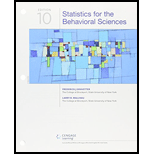
Concept explainers
21 . Within a population. the differences that exist from one person to another are often called diversity.
Researchers comparing cognitive kills for younger adults and older adults typically find greater difference. (greater diversity ,in the older population (Morse, 1993). Following are typical data showing problem-solving scores for two groups of participants.
Older Adults (average age 72)
738
845
266
Younger Adults (average age 31)
678
668
869
- Compute the
me.an , variance. and standard deviation for each group. - Is one group of scores 111.oticeabty more variable (more diverse) than the other?
Mean, variance and standard deviation for the two groups given also compare the variability of these two groups.
Answer to Problem 21P
Solution:
- Mean=5.467, variance=4.695, SD=2.167
- There is a significant difference between the SD of the two groups
Explanation of Solution
Here two groups are given we need to find the sample mean variance and SD and hence we need to compare that there is significant difference in SD`s. To do the problem will follow the steps that first mean then variance followed by SD hence we can compare these two SD.
Given:
We have provided with scores of two groups younger and olders. So, for this available data we will proceed toward solving the problem
Formula Used:
For sample of size n, we have below formulas
Mean=
Variance=
Standard Deviation (SD)=
Calculation:
For older
Here n=15, samples are given as also the calculation in the below table
| X | (x- |
| 9 | 12.4821 |
| 4 | 2.1521 |
| 7 | 2.3501 |
| 3 | 6.0861 |
| 8 | 6.4161 |
| 6 | 0.2841 |
| 2 | 12.0201 |
| 8 | 6.4161 |
| 4 | 2.1521 |
| 5 | 0.2181 |
| 7 | 2.3501 |
| 5 | 0.2181 |
| 2 | 12.0201 |
| 6 | 0.2841 |
| 6 | 0.2841 |
| Total= | |
Variance =
Standard deviation=
For Younger
Here n=15, samples are given as also the calculation in the below table
| X | (x- |
| 7 | 0.07129 |
| 9 | 3.00329 |
| 6 | 1.60529 |
| 7 | 0.07129 |
| 8 | 0.53729 |
| 6 | 1.60529 |
| 7 | 0.07129 |
| 6 | 1.60529 |
| 6 | 1.60529 |
| 8 | 0.53729 |
| 9 | 3.00329 |
| 7 | 0.07129 |
| 8 | 0.53729 |
| 6 | 1.60529 |
| 9 | 3.00329 |
| Total= | |
Variance =
Standard deviation=
Here there is a significant difference between the SD of the two groups for younger groups we get the less variability than the older groups. Hence, we can comment that there is less variability in the younger than the older groups.
Conclusion:
Here we can note that older group is more variable than the younger group, so we may comment that older are more dispersed than the younger.
Want to see more full solutions like this?
Chapter 4 Solutions
Bundle: Statistics for the Behavioral Sciences, Loose-leaf Version, 10th + MindTap Psychology, 1 term (6 months) Printed Access Card
- 9. The concentration function of a random variable X is defined as Qx(h) = sup P(x ≤ X ≤x+h), h>0. Show that, if X and Y are independent random variables, then Qx+y (h) min{Qx(h). Qr (h)).arrow_forward10. Prove that, if (t)=1+0(12) as asf->> O is a characteristic function, then p = 1.arrow_forward9. The concentration function of a random variable X is defined as Qx(h) sup P(x ≤x≤x+h), h>0. (b) Is it true that Qx(ah) =aQx (h)?arrow_forward
- 3. Let X1, X2,..., X, be independent, Exp(1)-distributed random variables, and set V₁₁ = max Xk and W₁ = X₁+x+x+ Isk≤narrow_forward7. Consider the function (t)=(1+|t|)e, ER. (a) Prove that is a characteristic function. (b) Prove that the corresponding distribution is absolutely continuous. (c) Prove, departing from itself, that the distribution has finite mean and variance. (d) Prove, without computation, that the mean equals 0. (e) Compute the density.arrow_forward1. Show, by using characteristic, or moment generating functions, that if fx(x) = ½ex, -∞0 < x < ∞, then XY₁ - Y2, where Y₁ and Y2 are independent, exponentially distributed random variables.arrow_forward
- 1. Show, by using characteristic, or moment generating functions, that if 1 fx(x): x) = ½exarrow_forward1990) 02-02 50% mesob berceus +7 What's the probability of getting more than 1 head on 10 flips of a fair coin?arrow_forward9. The concentration function of a random variable X is defined as Qx(h) sup P(x≤x≤x+h), h>0. = x (a) Show that Qx+b(h) = Qx(h).arrow_forward
- Suppose that you buy a lottery ticket, and you have to pick six numbers from 1 through 50 (repetitions allowed). Which combination is more likely to win: 13, 48, 17, 22, 6, 39 or 1, 2, 3, 4, 5, 6? barrow_forward2 Make a histogram from this data set of test scores: 72, 79, 81, 80, 63, 62, 89, 99, 50, 78, 87, 97, 55, 69, 97, 87, 88, 99, 76, 78, 65, 77, 88, 90, and 81. Would a pie chart be appropriate for this data? ganizing Quantitative Data: Charts and Graphs 45arrow_forward10 Meteorologists use computer models to predict when and where a hurricane will hit shore. Suppose they predict that hurricane Stat has a 20 percent chance of hitting the East Coast. a. On what info are the meteorologists basing this prediction? b. Why is this prediction harder to make than your chance of getting a head on your next coin toss? U anoiaarrow_forward
 Glencoe Algebra 1, Student Edition, 9780079039897...AlgebraISBN:9780079039897Author:CarterPublisher:McGraw Hill
Glencoe Algebra 1, Student Edition, 9780079039897...AlgebraISBN:9780079039897Author:CarterPublisher:McGraw Hill Big Ideas Math A Bridge To Success Algebra 1: Stu...AlgebraISBN:9781680331141Author:HOUGHTON MIFFLIN HARCOURTPublisher:Houghton Mifflin Harcourt
Big Ideas Math A Bridge To Success Algebra 1: Stu...AlgebraISBN:9781680331141Author:HOUGHTON MIFFLIN HARCOURTPublisher:Houghton Mifflin Harcourt Holt Mcdougal Larson Pre-algebra: Student Edition...AlgebraISBN:9780547587776Author:HOLT MCDOUGALPublisher:HOLT MCDOUGAL
Holt Mcdougal Larson Pre-algebra: Student Edition...AlgebraISBN:9780547587776Author:HOLT MCDOUGALPublisher:HOLT MCDOUGAL


